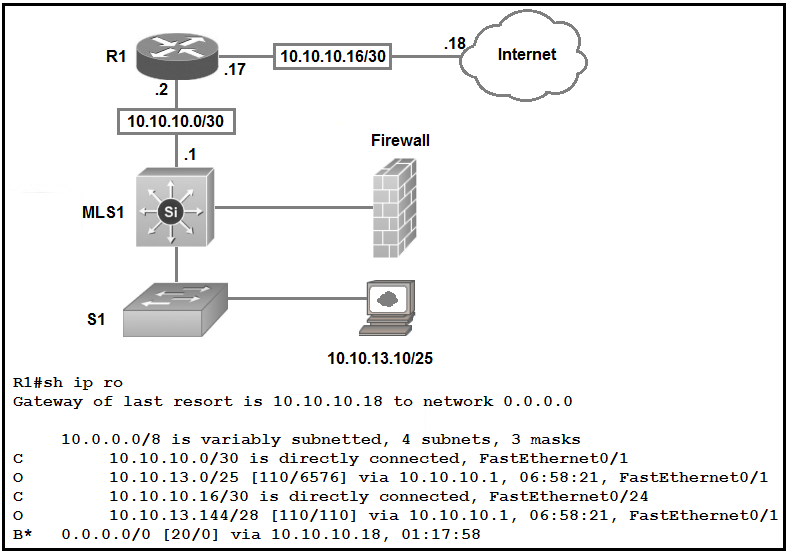
Refer to the exhibit. Which type of route does R1 use to reach host 10.10.13.10/32?

Refer to the exhibit. Which type of route does R1 use to reach host 10.10.13.10/32?
R1 uses a network route to reach host 10.10.13.10/32. The routing table contains a route to the network 10.10.13.0/25, which means it can reach any host within the 10.10.13.0 network, including 10.10.13.10. The subnet mask /25 indicates that this route is intended for the entire subnet, not just a single host, confirming that it is a network route.
A. default route The default route is 0.0.0.0/0, it is used to reach all destinations not included in the routing table. But the router already has a route to 10.10.13.10/32. The default route is not needed. Wrong answer. B. network route The routing table includes a route to 10.10.13.0/25. This subnet has these characteristics: 7 bits in the host ID = (2^7 – 2) = 126 IP addresses 1st IP address = 10.10.13.1 Last IP address = 10.10.13.126 This route includes address 10.10.13.10 and is an OSPF route (see the leading O). Correct answer. C. host route There’s no host route in the routing table. Wrong answer. D. floating static route A floating static route is used as a “backup” route to reach a subnet when the “main” route fails. But here the route to the host’s subnet is already in the routing table, and it is working. Wrong answer.
I passed my CCNA. Strangely, they don't show you your scores right away. I got that Credly badge and print out version of the cert. Some of the questions came from here and some were extremely different. So study really really hard.
I passed the exam yesterday, thank allah, i had 101 qestions with 3 labs. 80% of the questions are here. I will try to remember the questions and will let a mark for you on these questions as much as i remember. (look at the answers on my comments on each question, there where i will tell you if this question has been shown up). My only goal is to help you succeed, so do not hesitate to wish all the good for me. Good luck with your journey and i wish you pass this exam inshaallah. Give this comment a like so that others can read.
The correct answer is: B. Network route Because we need to use the dynamic protocol as it displays in the routing table in order to reach the 10.10.13.0 /25 network.
B is right answer
Greatting guys, I passed the exam on 07/13/2024, thank God, I had 83 questions with 3 laboratories. 80% of the questions here are in accordance with what colleagues said. Good luck with your journey and I wish you pass this exam. My advice to u is: Study the questions, don't memorize them, this is the only way you will pass the exam without any difficulties. I wish u all the luck on your journey and may God be with us.
I think D is correct answer
B is right because to reach the network: 10.10.13.0 /25 we should use dynamic protocol as OSPF- the shortest and fast protocol to reach the host.
B. Network route
My answer is B for floating static route - AD is always not default AD, like it should be greater than 110 or less than 110 (OSPF Default AD is: 110) so answer is not floating static route. for default route - ipv4 default route is 0.0.0.0. so answer is not default route for host route - the subnet mask will be /32 so answer is no host route thanks for the up votes
The answer is C. Look at the mask (/32). A host route is a route for one specific host so the mask must be /32.
C - host router by OSPF
B, is correct answer. Because Network route is used to select the best and shortest path in routing
B is right because we need to use dynamic protocol as it displays in the routing table in order to reach 10.10.13.0 /25 network.
Why is everybody assming the default network mask is /24 to calculate the subnets ip ranges ?
B. network route Explanation: R1 uses a network route to reach host 10.10.13.10/32. This can be determined from the routing table entry "10.10.13.0/25 [110/6576] via 10.10.10.1," which indicates that R1 has a route to the network 10.10.13.0/25 that includes the host 10.10.13.10. This is not a default route, host route, or floating static route.
Agree with B Contact me for full questions <a href="/cdn-cgi/l/email-protection" class="__cf_email__" data-cfemail="54393520203d203d27143b2120383b3b3f7a373b39">[email protected]</a>